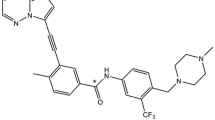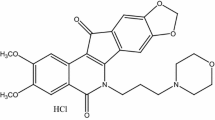Abstract
Optimal clinical performance of antineoplastic agents is realized by maximizing cytotoxicity toward cancerous elements while limiting drug action on normal tissue. Effectiveness is controlled by the absorption, distribution and excretion characteristics of the drug as well as its biotransformation pattern. Biotransformation is a particularly important consideration in clinical utilization of chemically reactive molecules, such as cisplatin. Such compounds are known to rapidly degrade once in contact with blood components (1). This breakdown apparently results from nucleophilic displacement of chloride ligands by endogenous nucleophiles either directly or through aquatedplatinum intermediates (2). Coordination of platinum with these nucleophiles yields complexes apparently exhibiting different spectra of biological activity and toxicity, and different distribution and excretion characteristics. Thus, a discussion of the clinical pharmacology and pharmacokinetics of cisplatin must be based on quantitative data describing the fate of the individual platinum species differing in ligand composition about the metal as well as an evaluation of the biological activity of these individual biodegradation products. Although the degradation reactions are apparently not enzyme-mediated, general “metabolic” pathways should be definable; the structure of specific reaction products, however, may vary among individuals, being determined by the nature and concentration of potential reactant molecules (those with available nucleophilic centers) which in turn are influenced by a variety of environmental, dietary and health factors. This chapter describes some of the sensitive analytical methodology developed in our laboratories to selectively monitor individual platinum-containing species and the application of that technology to begin to describe the disposition of cisplatin in man in clinically relevant situations and in animals.
Access this chapter
Tax calculation will be finalised at checkout
Purchases are for personal use only
Preview
Unable to display preview. Download preview PDF.
Similar content being viewed by others
References
Butour JL, Macquet JP. 1978. Europ J Biochem, 78, 455; 83, 375.
Repta AJ, Long DF. 1980, in “Cisplatin: Current Status and New Developments”, Prestayko AW, Crooke ST, Carter SK, eds., Academic Press, New York, pp. 285–304.
Bannister SJ, Sternson LA, Repta AJ. 1978. Clin Chem, 24, 877.
Preisner D, Sternson LA, Repta AJ. 1981. Anal Letters, 14, 1255.
LeRoy AF, Wehling ML, Sponseller H, et al. 1977. Biochem Med, 18, 184 and references therein.
DeConti RC, Toftness BR, Lange RC, Creasy WA. 1973. Cancer Treat Rept, 33, 1310.
DeSimone PA, Yancey RS, Coupai JJ, Butts JD, Hoeschele JD. 1979. Cancer Treat Rept, 63, 951.
Bannister SJ, Sternson LA, Repta AJ, James GW. 1977. Clin Chem, 23, 2258.
Riley CM, Sternson LA, Repta AJ. 1981. J Chromatogr, 217, 405.
Riley CM, Sternson LA, Repta AJ. 1981. J Chromatogr, 219, 235.
Riley CM, Sternson LA, Repta AJ, Siegler RS. 1982. J Chromatogr, 229, 373.
Riley CM, Sternson LA, Repta AJ. 1982. Anal Biochem, 124, 167.
Bannister SJ, Sternson LA, Repta AJ. 1983. J Chromatogr, 273, 301.
Marsh KC, Sternson LA, Repta AJ. 1983. Anal Chem, submitted.
Himmelstein KJ, Patton TF, Belt RJ, Taylor S, Repta AJ, Sternson LA. 1981. Clin Pharmacol Ther, 29, 658.
Riley CM, Sternson LA, Repta AJ, Bannister SJ. 1982. J Pharm Pharmacol, 34, 826.
Riley CM, Sternson LA, Repta AJ. 1983. Anal Biochem, 130, 203.
Barber M, Bordoli RS, Sedgwick RD, Tyler AN, Bycroft BW. 1981. Biochem Biophys Res Commun, 101, 632.
Aberth W, Straub KM, Burlingame AL. 1982. Anal Chem, 54, 2029.
Mattox D, Sternson LA, vonHoff DD, Kuhn J. 1983, Arch Otolaryng, in press.
Patton TF, Repta AJ, Sternson LA, Belt RJ. 1982. Int J Pharm, 10, 77.
Himmelstein KJ, Patton TF, Repta AJ, Sternson LA. Unpublished data.
LeRoy AF, Lutz RJ, Dedrick RL, Litterst CL, Guarino AM. 1979. Cancer Treat Rept, 63, 59.
Robins AB, Leach MD. 1983. Cancer Treat Rept, 67, 245.
Editor information
Editors and Affiliations
Rights and permissions
Copyright information
© 1984 Martinus Nijhoff Publishing, Boston
About this chapter
Cite this chapter
Sternson, L.A., Repta, A.J., Shih, H., Himmelstein, K.J., Patton, T.F. (1984). Disposition of Cisplatin vs Total Platinum in Animals and Man. In: Hacker, M.P., Douple, E.B., Krakoff, I.H. (eds) Platinum Coordination Complexes in Cancer Chemotherapy. Developments in Oncology, vol 17. Springer, Boston, MA. https://doi.org/10.1007/978-1-4613-2837-7_12
Download citation
DOI: https://doi.org/10.1007/978-1-4613-2837-7_12
Publisher Name: Springer, Boston, MA
Print ISBN: 978-0-89838-619-6
Online ISBN: 978-1-4613-2837-7
eBook Packages: Springer Book Archive




